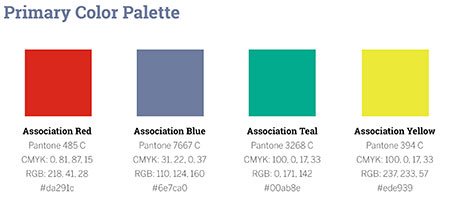
The Skinny on Style Guides (Part Two): Putting It All into Practice
So you’ve read about the importance of style guides, talked to your colleagues, and gotten all of the organization’s stakeholders on board—you’re ready to write a style guide. But where do you begin?
The process of developing a guide is customizable to your needs. If you only are concerned about the tone used across your marketing channels, you can develop a guide for just that.
Or, if you simply want something to share with outside vendors like web developers or printers, you can develop a short guide with only information related to those projects.
However, if you have the time and the resources, I recommend developing a more comprehensive document that can be used by every partner with whom you do business, both within your organization and outside of it.
It doesn’t have to be long, but the more comprehensive your style guide is, the more consistent your brand will be across all media.
Identifying Your Audience
You likely have an idea of who you’re trying to reach and where they are, but it never hurts to get a holistic overview of everyone in your target audience. Research current and prospective members to better understand their demographics, asking yourself questions such as
- How do these people communicate with one another and with our organization?
- Where do these people communicate with one another and with our organization?
- What is the nature of their work and/or their relationship with us?
- What needs do they have, and how do we fulfill those needs?
- How do my competitors communicate with these people?
To ensure you understand your brand inside and out, research your own organization in the same way. Ask yourself and your colleagues questions like
- What is our attitude toward what we do?
- What purpose do we serve?
- How do we fulfill that promise?
Conducting a SWOT analysis of your current communications methodology also can help you identify the areas that are working—and the areas that aren’t—helping you prioritize what to include in your guide.
Getting into the Guide
Although your style guide will be completely unique to your organization and needs, you may want to include information about:
The Background
Your organization’s mission and vision serve as the backbone for everything you do; they also can serve as important context for everything in your style guide. Include a short section with your mission, vision, company background, and other important “biographical” details to give uses that context.
Plus, if you haven’t analyzed your mission and vision statements in a while, this is a good opportunity to ensure they still are relevant to your audience and supported by your communications strategy.
The Words
A large part of your audience’s perception of your brand comes from what you say and how you say it. To ensure every publication is on point, cover the following in your style guide:
The Fundamentals
Many associations already are aligned with a style or styles based on the work their members do. For example, members of healthcare organizations often are familiar with APA and AMA styles, and writers likely have a copy of the AP or Chicago style guide in their bookshelves.
If you want to save time on building out your guide, but still ensure every comma and period is on point, try adopting one of these styles and listing only exceptions—rather than every rule—in your own guide.
Tone & Voice
Although directly related, tone and voice are not the same. Your voice describes the character of your brand; your tone describes how that character is expressing themselves at that moment.
When developing the section on voice, ask yourself questions like
- Does our organization use slang?
- Are we more casual, or more formal?
- What makes us stand out from our competitors? How do we communicate that difference?
- Do you use jargon, or is simple language always best?
To communicate your preferred voice, try selecting a few keywords that perfectly describe what you are—and, if you like, what you’re not. MailChimp has an excellent example of this in their own style guide, stating that the company is “fun, but not silly” and “confident but not cocky.”
(Another great part of MailChimp’s style guide is that the company allows others to use it as a template for free!)
Developing your tone is very similar, but remember that tone changes based on what you’re communicating. So, for example, if your voice is informal and friendly, you may want to specify that on social media, humor is encouraged, while in white papers, clearer and more direct—yet still casual—language is preferred.
In the case of tone, examples also are helpful. Don’t just say that your tone is playful, pick out a few examples of particularly good marketing across various media and describe why that particular type of playfulness best describes the tone you’re looking to achieve.
Commonly Used (and Misused Words)
Do you write health care as one word or two? Does someone on your staff always use the word “comprise” when they mean “compose”? This is the section to include all of the nitty-gritty details that aren’t covered by your primary style or that differ from it.
For more on brand voice, check out this previous AMC blog post.
The Look
A picture is worth a thousand words—so make sure all of yours are saying the right things!
This section of your style guide should cover everything from color palettes and logos to the types of graphics, fonts, and photography you prefer, and should include:
Brand Colors, Logos, and Fonts
Many organizations have several variations on their corporate logos, which can be confusing for staff and outside vendors alike. In this section of your style guide, dictate which logos should be used when, offering both pictures and file names/server locations to ensure the correct one is selected every time. If you also have guidelines about where the logo should be placed in relation to other content, specify them here, as well.
Similarly, if you don’t offer very specific instructions, your brand colors could look different on a wide variety of media, sending mixed messages to your audience. In this section, list as many color codes for your palette as possible—including RGB/decimal, PMS, and hex codes as well as Pantone numbers, if applicable. It also is beneficial to include images for each color and suggestions for how to pair the primary, secondary, and tertiary colors in your palette.

If you have preferred typefaces or fonts—or any guidance on formatting—list those in the visual portion of your style guide, too. This will ensure there aren’t any Comic Sans statements in what should be a Times New Roman kind of publication.
Image Options

Is your style more serious

or playful?
Does your brand lend itself more to caricature-style drawings or staged snapshots? Do you prefer black and white, or is all-color more your style? This is the place to detail all of that information. Include both visual examples and evocative keywords—such as moody, realistic, fun, or whimsical—to help describe the style of imagery you prefer.
If you have guidelines for file type, resolution, or size of the images and graphics used across various media, ensure that information makes it into this section, as well.
And Remember…
Regardless of how you decide to tackle your style guide, remember: it is a living document that reflects your organization’s path, purpose, and lifespan. Although consistency is key, it can change as your organization and membership evolves. Now get writing!
Be the first to know about the latest news and events from AMC. Sign up for our emails!


